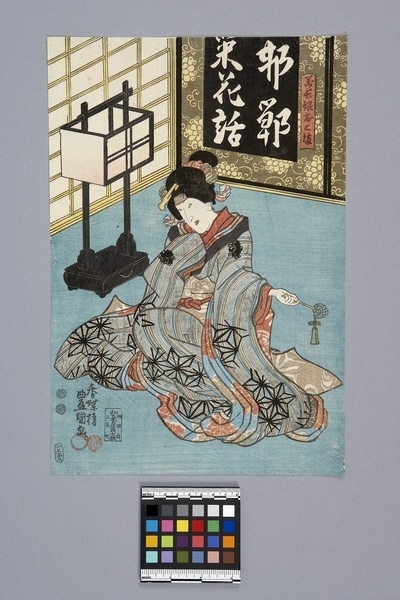Manchōmusume Okoma Item Number: N2.1168 from the MOA: University of British Columbia

Description
Print of a female figure sitting on the floor, with a screen in the background. The print is the left half of a pair; it would be shown with N2.1167 on the right side. Together show a scene of three figures, with a large screen in the background. This part shows a woman sitting on the floor with her head bent slightly toward the floor. Her left arm is extended; she holds a flower with a bell in her left hand. She is wearing a kimono with a black star-shaped print on a blue, beige, and grey striped pattern. In the lower right corner there is a circular red seal, an oval black seal, black characters, and a vertically rectangular black seal. The print is made of two vertically rectangular pieces, creating a horizontally rectangular image overall.
History Of Use
This type of ukiyo-e print is referred to as ōban nishiki-e (大判錦絵). Ōban refers to a print size about 24-25cm x 32-37 cm, and nishiki-e refers to multi-colored woodblock print.
Iconographic Meaning
The female sitting on the floor represents Manchōmusume Okoma (万長娘おこま), played by kabuki actor, Iwai Kumesaburō III (三代目岩井 粂三郎).
Narrative
This print by Utagawa Kunisada (歌川国貞) (aka Utagawa Toyokuni III 三代目歌川豊国/豊國) is titled, Manchōmusume Okoma (万長娘おこま), and is paired with print N2.1167. The print depicts a scene of kabuki, Sekai no hana Oguri gaiden (世界花小栗外伝) first performed in April 1851, at Nakamura-za (中村座), the oldest Edo kabuki theatre in Tokyo.
Item History
- Made by Kunisada Utagawa (Maker) in Japan during 1851
- Collected between 1911 and 1930
- Owned by James Fyfe-Smith and Mary G. Fyfe-Smith
- Owned by Florence Fyfe-Smith before 1957
- Received from Florence Fyfe-Smith (Donor) during 1957
What
- Name
- Manchōmusume Okoma
- Identification Number
- N2.1168
- Type of Item
- Manufacturing Technique
- woodblock printed
- Overall
- height 36.0 cm, width 24.5 cm
Who
- Culture
- Japanese
- Creator
- Kunisada Utagawa (Maker)
- Previous Owner
- James Fyfe-Smith, Mary G. Fyfe-Smith and Florence Fyfe-Smith
- Received from
- Florence Fyfe-Smith (Donor)
Where
- Holding Institution
- MOA: University of British Columbia
- Made in
- Japan
When
- Creation Date
- during 1851
- Collection Date
- between 1911 and 1930
- Ownership Date
- before 1957
- Acquisition Date
- during 1957
Other
- Item Classes
- works on paper
- Condition
- good